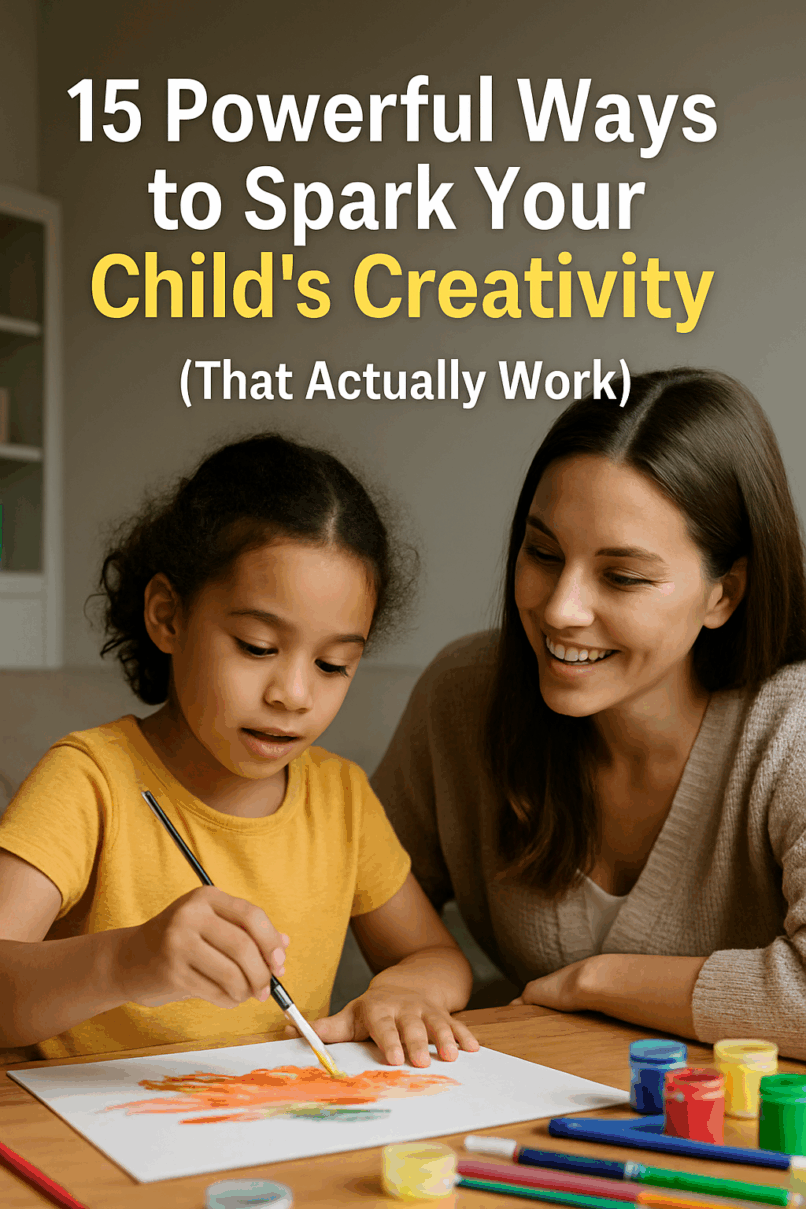
simply amazing, always for you.
As parents, we all want our children to grow up confident, curious, and capable of solving problems. But in a world of rigid school routines, screens, and standardized testing, fostering creativity can easily take a back seat. Yet creativity is more than drawing or painting—it’s about thinking differently, finding solutions, and expressing unique ideas.

If you’ve ever wondered how to encourage your child’s creativity, you’re not alone. This article will give you real-world strategies that don’t require expensive tools or overwhelming changes. Whether your child is a toddler or a teen, there are simple yet powerful ways to unlock their creative potential.
Why Creativity Matters in Child Development
Creativity is not just about art—it’s about how a child approaches life. A creative child is more likely to:
- Solve problems independently
- Express emotions constructively
- Think critically and innovatively
- Adapt to new situations
- Develop a strong sense of self
Encouraging creativity early lays the foundation for cognitive, social, and emotional development. It helps children become not just dreamers but doers.
1. Create a Safe Space for Ideas
Children thrive when they feel safe expressing themselves without fear of criticism. If they feel judged for being “weird” or “wrong,” they may shut down creatively.
How to do it:
- Avoid correcting or dismissing imaginative ideas (“That’s silly!”)
- Celebrate all efforts, not just the “good” ones
- Use open-ended questions: “What made you think of that?”
When children know their thoughts are respected, they feel freer to explore them.
Tip: Be patient when your child’s ideas don’t make sense at first—creativity often looks messy before it turns into something meaningful.
2. Encourage Play—Especially the Unstructured Kind
Play is a child’s natural language. It’s how they experiment, discover, and invent.
Unstructured play, without rules or goals, is particularly important for creativity. It invites exploration and self-expression.

Ideas for unstructured play:
- Let them build with blocks without instructions
- Encourage make-believe games
- Offer household items like cardboard boxes, spoons, or old clothes for DIY fun
Avoid over-scheduling your child’s day with lessons and activities. Give them boredom—it often sparks brilliance.
Related: How to Handle Your Toddler’s Tantrums: A Guide for Parents
3. Provide Creative Tools—Not Just Toys
While toys can be fun, they often come with predefined roles. A toy phone is used as a phone, while a lump of clay could become anything.
Offer open-ended materials that inspire invention:
- Paper, crayons, markers, paint
- Clay, Play-Doh, modeling foam
- Old boxes, tape, glue, scissors
- Costumes and props for role-playing
- Music instruments, even homemade ones
Don’t worry about the mess—creativity is often gloriously untidy.
4. Allow Time for Deep Focus
Children need time to get into the creative zone—the state where they lose track of time because they’re so absorbed in what they’re doing. Constant interruptions break this state.
How to help:
- Block out time where they’re not rushed
- Limit screen time during these hours
- Let them follow their interests deeply, even if it’s just drawing dinosaurs for days
Protecting their focus is a gift that helps their imagination flourish.
5. Model Creativity Yourself
Children learn far more from what you do than what you say. Show your own creative side—whether it’s cooking, gardening, writing, or fixing things.
Try this:
- Paint or draw together
- Write silly poems as a family
- Solve puzzles or build things as a team
When your child sees you engaging creatively, they see it as a natural and valuable part of life.
Related: How to Be a Patient Parent: Tips for Managing Your Emotions
6. Let Go of “Perfection”
Creativity dies under the pressure to be perfect. If a child feels their art must look a certain way, or their story must make sense, they may start censoring themselves.
What to do:
- Praise effort and imagination, not results
- Avoid correcting the “right” way to do something
- Celebrate mistakes as part of the process
Say things like:
“That’s such an interesting idea—tell me more!”
“I love how you tried something new.”
“What would happen if you changed this?”
7. Expose Them to the Arts and Culture
Creativity is fueled by inspiration. Take your child into environments that broaden their minds:
- Visit museums, art galleries, and science centers
- Attend plays, music performances, or storytelling events
- Explore different cultures through food, books, and festivals
Even watching documentaries or reading folktales from different parts of the world can spark new ideas.
8. Encourage Curiosity, Not Just Answers
Instead of rewarding only correct answers, encourage your child to ask questions and explore possibilities.
Try this:
- “What do you think will happen if…?”
- “How else could we solve this?”
- “Why do you think that happened?”
When curiosity is celebrated, creativity follows.
Related: How to Set Boundaries with Your Children (Without Feeling Bad)
9. Support Their Interests—even the Strange Ones
Today it might be dinosaurs. Tomorrow it’s origami. Next week it’s making slime. Support whatever captures their attention.
Let them dig deep. Buy a book on that topic. Watch a documentary together. Help them build something based on their interest.
Even if it seems trivial to you, it’s training their brain to be passionate, self-directed, and persistent.
10. Limit Screen Time and Over-Scheduling
Creativity thrives in free time, not screen time. While some apps and videos may be educational, they often give answers instead of inspiring exploration.
Also, kids who are constantly in lessons (music, karate, tutoring) may not have time to just think and invent.
Create downtime in their schedule—time to dream, play, and create without rules.
11. Celebrate Creativity in All Forms
Creativity isn’t just about art. It’s everywhere:
- A new way of tying shoelaces
- Inventing a game for their siblings
- Asking a weird “what if?” question
- Creating a new sandwich recipe
Let them know that all forms of creativity count—from writing stories to solving math in unconventional ways.
12. Avoid Comparing Your Child’s Work
Nothing stifles creativity more than comparison. Saying “Your cousin draws better” or “Why can’t you be more like…” can kill a child’s confidence.
Instead, highlight their individuality.
Say things like:
- “I love how you made this your own.”
- “That’s such a cool idea—I haven’t seen anything like it!”
13. Give Them Creative Freedom
Sometimes, children just need space to express themselves their way. Maybe your child wants to wear mismatched socks or draw purple trees. Let them.
The more freedom they have to express themselves, the more confident and creative they become.
Related: Why Timeouts Aren’t Always Effective: Alternative Discipline Strategies
14. Keep a Creativity Journal Together
A creativity journal can help children track and reflect on their ideas. You can keep a family one, or encourage each child to have their own.
Use it for:
- Doodling
- Writing short stories
- Jotting down dreams
- Making up jokes
- Drawing inventions
It’s a great way to make creativity part of everyday life.
15. Praise the Process, Not the Product
Children need to feel valued for the effort, not the outcome. When they feel pressure to “make something good,” they may avoid trying at all.
Shift your language to focus on their thinking and persistence:
- “You really stuck with that, even when it was hard.”
- “I love how you tried something new.”
- “You had such an original idea!”
Raising Creative Kids in a Structured World
Creativity isn’t just for artists—it’s a mindset. It’s about seeing the world not just as it is, but how it could be. As a parent, you don’t need to have all the answers—you just need to provide the space, tools, and encouragement for your child to discover them.
By nurturing their creativity today, you’re giving your child the confidence, curiosity, and courage to thrive tomorrow.
suggested reads:
- How to Handle Your Toddler’s Tantrums: A Guide for Parents
- How to Be a Patient Parent: Tips for Managing Your Emotions
- How to Set Boundaries with Your Children (Without Feeling Bad)
- What I Wish I Knew Before Becoming a Parent
- Why Timeouts Aren’t Always Effective: Alternative Discipline Strategies

Support Our Website!
We appreciate your visit and hope you find our content valuable. If you’d like to support us further, please consider contributing through the TILL NUMBER: 9549825. Your support helps us keep delivering great content!
If you’d like to support Nabado from outside Kenya, we invite you to send your contributions through trusted third-party services such as Remitly, SendWave, or WorldRemit. These platforms are reliable and convenient for international money transfers.
Please use the following details when sending your support:
Phone Number: +254701838999
Recipient Name: Peterson Getuma Okemwa
We sincerely appreciate your generosity and support. Thank you for being part of this journey!
